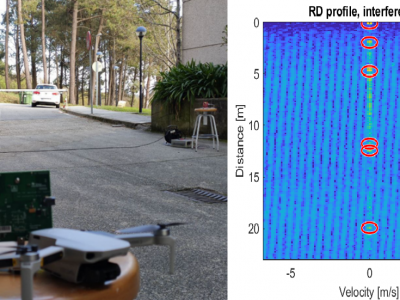FMCW radar

For gesture recognition, radar sensors provide a unique alternative to other input devices, such as cameras or motion sensors. They combine a low sensitivity to lighting conditions, an ability to see through surfaces, and user privacy preservation, with a small form factor and low power usage. However, radar signals can be noisy, complex to analyze, and do not transpose from one radar to another.
- Categories:
 305 Views
305 ViewsIn the attached dataset, a continuous record of 2493 chirp-sequence FMCW radar burst is presented. The data consist of the direct ADC output of an AWR1443BOOST radar board from Texas Instruments during 47.37 s of continuous operation. During this time, two FMCW radars of the model AWR1642BOOST were continuously transmitting sweeps with its main lobe aimed towards the first radar. This produces the apparition of two different uncorrelated interferences at the victim radar side, which can be seen on different indexes of the provided capture.
- Categories:
 817 Views
817 Views
The development in the automation sector and aircraft design has enabled enormous innovations in the urban aviation sector, which includes Advanced Air Mobility (AAM). AAM includes the on-demand air transportation of goods and passengers using the drone between aerodromes within Air Corridors. Air Corridors are an integral part of AAM, a performance-based controlled airspace where drones follow a specific set of protocols. This includes appointing the Skylane, route availability, traffic control, collision avoidance, etc.
- Categories:
 336 Views
336 Views
A wide range of wearable sensors exist on the market for continuous physiological health monitoring. The type and scope of health data that can be gathered is a function of the sensor modality. Blumio presents a dataset of synchronized data from a reference blood pressure device along with several wearable sensor types: PPG, applanation tonometry, and the Blumio millimeter-wave radar. Data collection was conducted under set protocol with subjects seated at rest. 115 study subjects were included (age range 20-67 years), resulting in over 19 hours of data acquired.
- Categories:
 2744 Views
2744 Views
